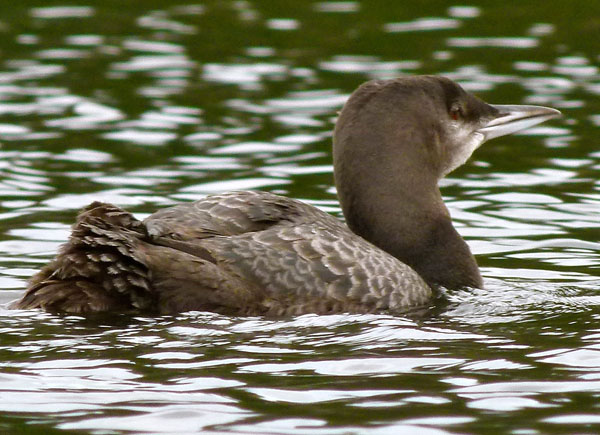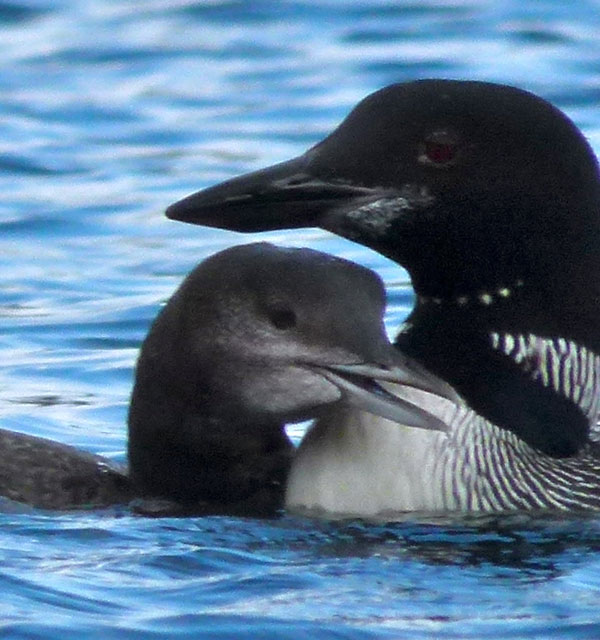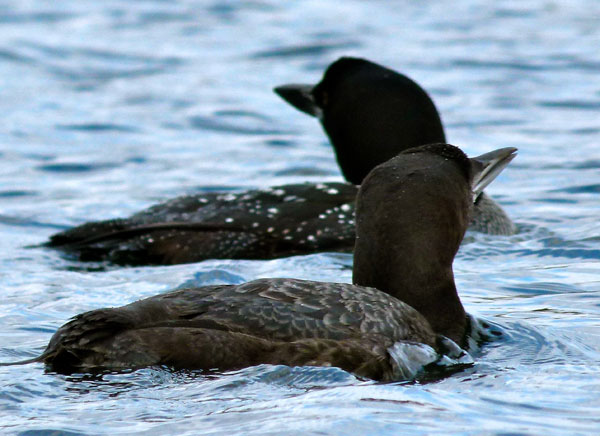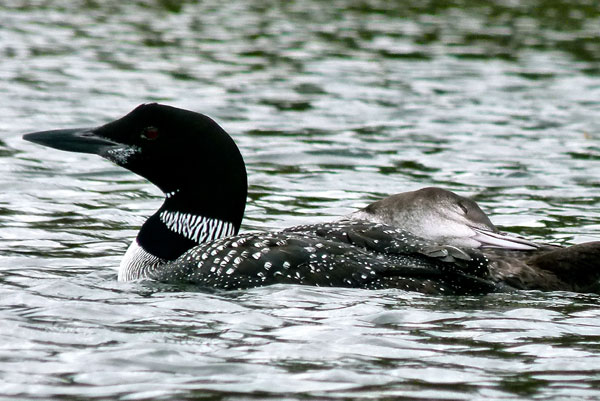
Little Loon is 13 weeks old and thriving! Now that it’s a champion diver with a razor sharp bill and can escape danger, (especially the kayak with the frozen human in it) it’s much more confident and stays alone while the parent dives for food without being fearful and constantly peeping.
It makes a softer, deeper sound every once in a while now. It has mastered all of the numerous loon positions for preening, diving, and stretching, but I haven’t seen it catch its own food. The parent fed it yesterday. Maybe when I go next week, weather permitting, it will surprise me, but hopefully not with a leech. You might notice that the adult’s bill is losing some of its black color. Their plumage loses its color and changes to a gray brown similar to the chick’s while it winters on the coast, but all of the research says that the bill stays black. If anyone knows anything about this subject, please leave a comment.












Thank you. I have enjoyed your loon reports. True community service. JC
The young loon’s evolution into adulthood reminds me of raising human children. They come and they go and they are independent but not totally, returning to parents for nurturing (feeding and laundry) for quite a while.
Thank you, Jane,
Judith Anne, a loon fan from Ashland, Oregon
I dub thee the “Loon Lady”
:)
A while back Nancy asked if one adult and the oldest chick might have flown off. At first I didn’t think that was likely. But apparently no one has found a dead chick and when a chick or loon dies on a pond someone almost always finds the body. People who see the loons on the pond daily told me that the older chick was feeding itself and was practicing flying before it disappeared. Most observers think that the remaining chick is the younger one.
So Nancy’s scenario is a good possibility. In the meantime lets pray that the pond does not freeze over trapping the chick. Thank you again Jane for the wonderful pictures. They are the best as a group that I have ever seen. Next yesar I hope you get pics of nesting and birth.
As always,fantastic photos. Thank you so much for sharing these:)
Great shots Jane, waiting to see the next!
Thank you! What a lovely smile the chick gave to us in the third photo!
Here’s the answer to my own adult molting question:
Adult Common Loons start their fall/winter molt with the loss of pigmentation at the base of the bill, and loss of pigmentation in the facial feathers around the bill. Note other feather changes on the neck and the loss of some of the square patterns on the scapular feathers of the back.
The last photo is a good example of this.
Jane,
This posting is one of the best collections of family photos I have ever seen! The adults may leave the lake soon and I hope the chick will find some friends for its trip to the ocean.
There are several photos of adult loons in winter plummage in the book, Call of the Loon, published in 2006. One shows the beak to be black but others are quite faded. I would recommend contacting Biodiversity Research Institute with that question. The organization studies banded loons – website is http://www.briloon.org .
I commend you for braving that cold kayak to continue this project!
Nancy Prince
Thank you so much Nancy, and everyone else.
Seeing the loon family interactions is really eye opening. Very few of us have experienced this sight, myself included, until this project began. I’ve spent so much time watching them, that I’ve learned to recognize cues for interaction time.
I’ve seen winter plumage photos, but it was the loss of pigmentation that was baffling me until I read the above information last night.
Thanks for the book suggestion.
I’m hoping to get more photos next week, even it means ice kayaking.
Jane
OMG again…. truly amazing photos….. you take such wonderful pictures. I have enjoyed watching the changes in the babies, and such dedication the adult loons take with them. As is the dedication you have taken following them all summer. Great Job ! ! !
This is so great!! I look forward to it every week . Great pictures every time. I’m in NC working, this brings me back to home. Thank you so much for this Jane.
jane!!!! just shared these wonderful photos with emme. perhaps now we’ll take in a little of “the only one club” ! could we even find “the only one” who wouldn’t enjoy these photos??
What more can I say beyond what others have already shared!! I am just a forever-homesick, disabled-senior, legally-blind, [thank God for computers!], Mainer who now lives in Maryland. I have always, since early childhood, loved the loons of Miane’s lakes, especially Porter Lake, so much so that my mother decided many years ago that I WAS a bit looney! I too am amazed that you would suffer the hours you doeach week in a frozen kyack for this wonderful series to document this amazing and changing family! I have learned a LOT, quite something for an old lady who thought she already knew a lot about loons. But mostly, I have so enjoyed this series and look orward to each Sunday night to see the new ones. Also. I still believe with a bit more research to answer your own questions, that you have a wonderful book here – hopefully a coffee-table book!
Good Luck and I’ll look for even more pictures next week and hope fall weather, warm fall weather, returns for another week or two, or three. Surely the hunters can wait a few weeks for tracking deer in a light covering of snow, don’t yiou think?